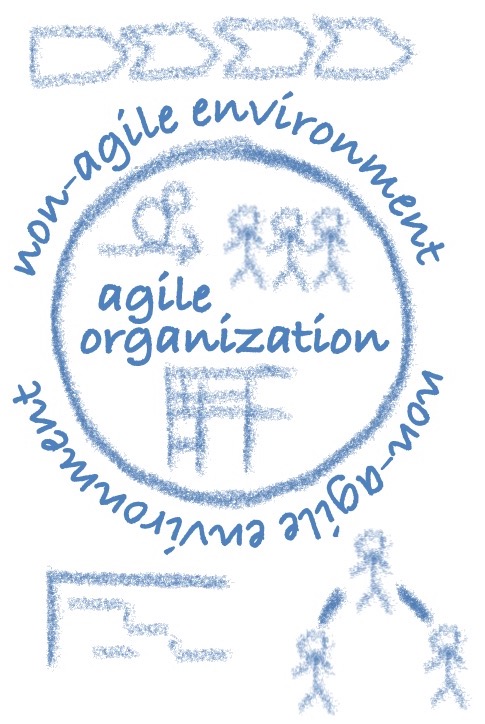| |
Details
The "Abstract" section above explains why it is essential to accept that our environment is not agile.
We need to learn how to map at the border, from outside (non-agile) to inside (agile)
vice versa.
Many people fail to implement it, because mapping
>a controlled approach and a self-organized approach<
is anything but simple.
It is peopleware, not hardware or software.
The following paragraphs show some examples for successful implementations in my past.
An automotive supplier creates embedded systems with software on hardware in a housing.
These might be radar devices for detecting other vehicles to support advanced driver assistent vehicle systems.
Therefore, hundreds of engineers may work in multiple teams in several countries together in one project for maybe two years.
The systems engineering guys may derive a technical architectural design from the requirements and constraints.
The software teams develop the features in bunches, satisfying requirements and design decisions.
Both apply the
>corporate standard processes<
that satisfy the regulatory and customer standards.
While the system guys are pushed hard by customer and managers to modify the design whenever the need changes or misbehavior is
discovered, they still try to work according to the system processes and to consider all functional safety aspects.
The software teams do their Scrum Sprints according to the changes in their Backlogs, and they apply the software processes within
the Sprints in cross-functional teams.
This works fine when you organize it in a way that the system guys work upfront hunting for a new baseline, then the software teams
do their development Sprints, and everything gets integrated and tested continuously.
When the system guys learn to baseline often, when the software Sprints are kept short, when stubbing is introduced,
and when automated continuous integration and regression testing is applied,
then the overall progress can be really smooth and fast.
This also supports a
>Product Family Engineering<
approach where the system guys are then working traditionally on an Architecture/Reference level of the platform
and the software teams are working agile on the Component level, with a clearly organized mapping at the border.
Traditional management estimates the needed human resources by head count calculations
based on expected development efforts (hours).
This habit can be continued based on the role definitions of the classical standard processes.
The related work then can be broken down into stories that are realized by T-shaped people in cross-functional team work
within the agile organization, still working compliant to the detailed technical development sub-processes.
The agile teams can easily track their efforts per Sprint from the task boards and the evaluated team velocity, and then the
Scrum Master and Product Owner can compare it to the original estimations.
Deviations should be discussed in the Rstrospective sessions.
Enterprise managers love steering committees, decision boards and PowerPoint reporting of
melon projects (looking green while being dark red internally).
This can still be supported by agile project teams, when they pass back the Sprint Goals as corrected milestones of the project plan,
use Burndown Charts data as calculation base for the given PowerPoint templates,
take the decisions (if any are made by accident) to the teams' Refinement sessions,
and transfer the weird management view systematically into Epics and Stories.
The Product Manager or Project Manager may take the role of the Product Owner or Scrum Master (different approaches are
practiced in the wild), but should be strong enough to face the Enterprise managers to support the mapping.
I love to do Lessons learned sessions often, and the agile Retrospective events are nothing else for me,
but now some teams tend to really doing it.
Make an extra session/event for the interface to the non-agile environment, with people from both sides.
Anyway, ensure that only a few topics are collected to be improved, and instantly add at least one action to the backlog
of the next Sprint.
Don't collect a thousand bad points and then do nothing!
It is all about >improving standard processes<
by best practices, team trial-and-error, or personal learning the hard way.
"If you always do what you've always done, you'll always be who you always have been."
|
|
